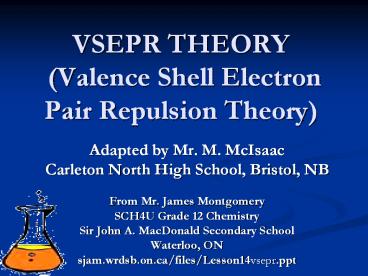VSEPR THEORY (Valence Shell Electron Pair Repulsion Theory)
1 / 14
Title:
VSEPR THEORY (Valence Shell Electron Pair Repulsion Theory)
Description:
VSEPR THEORY (Valence Shell Electron Pair Repulsion Theory) Adapted by Mr. M. McIsaac Carleton North High School, Bristol, NB From Mr. James Montgomery –
Number of Views:585
Avg rating:3.0/5.0
Title: VSEPR THEORY (Valence Shell Electron Pair Repulsion Theory)
1
VSEPR THEORY (Valence Shell Electron Pair
Repulsion Theory)
- Adapted by Mr. M. McIsaac
- Carleton North High School, Bristol, NB
- From Mr. James Montgomery
- SCH4U Grade 12 Chemistry
- Sir John A. MacDonald Secondary School
- Waterloo, ON
- sjam.wrdsb.on.ca/files/Lesson14vsepr.ppt
2
What Is The VSEPR Theory?
- VSEPR Theory is used to predict the shapes of
molecules. - Think of bonded pairs (shared) or lone pairs
(nonbonded, unshared) of e-s as negatively
charged clouds that repel each other. - To achieve the most stable condition the clouds
must be as far apart as possible in 3-D, thereby
decreasing repulsion. - The amount of repulsion can be ordered
- LP-LP gt LP-BP gt BP-BP
- In order to determine the shape, the Lewis
diagram must be drawn first.
3
2 Bond Pairs/Electron Groups
- Molecules that only have 2 bonding pairs on the
central atom will have a LINEAR SHAPE with a bond
angle of 180 - e.g. BeF2, CO2, CS2
- General Formula AX2
- Central atom A from group 2 2 BP 0 LP
4
Example BeF2
5
3 Bond Pairs/Electron Groups
- Molecules that have 3 bonding pairs on the
central atom will have a TRIGONAL PLANAR SHAPE
with bond angles of 120. - e.g. BF3, BH3
- General Formula AX3
- Central atom A from group 13 3 BP 0 LP
6
Example BF3
7
4 Bonding Pairs/Electron Groups
- If the central atom is placed at the center of a
sphere, than each of the four pairs of electrons
will occupy a position to be as far apart as
possible. - This will result in the electron pairs being at
the corners of a regular tetrahedron, therefore
these molecules are said to have a TETRAHEDRAL
SHAPE. - The angle between each bond will be 109.5
- e.g. CCl4, CH4, SiH4
- General Formula AX4
- Central atom A from group 14 4 BP 0 LP
8
Example CCl4
9
3 Bonding Pairs 1 Non-bonding Pair
- Four pairs of electrons will always arrange
themselves tetrahedrally around the central atom. - The shape of the molecule is determined by the
arrangement of the atoms not the electrons. - As a result such molecules will have a TRIGONAL
PYRAMIDAL shape. - Due to the repulsion, a non-bonding electron pair
requires more space than a bonding pair, the
angles in these molecules are 107 not 109.5 as
in the tetrahedral molecules. - e.g. NH3, PCl3
- General Formula AX3E
- Central atom A from group 15 3 BP 1 LP
10
Example NH3
11
2 Bonding Pairs 2 Non-bonding Pairs
- The four pairs of electrons will be arranged
tetrahedrally but since only 2 pairs are bonding
electrons, the surrounding atoms are at 2 corners
of the tetrahedron. - As a result these molecules will have a V-SHAPE
or BENT. - The repulsion between the non-bonding pairs will
result in a bond angle of 104.5. - For each pair of non-bonding electrons, the bond
angle decreases by 2.5 - e.g. H2O, H2S, OCl2
- General Formula AX2E2
- Central atom A from group 16 2 BP 2 LP
12
Example H2O
13
Things to Remember
- In order to predict the shape of a molecule you
must draw the Lewis Dot Diagram for the molecule,
determine the number of bonding and non-bonding
electron pairs and compare this with the chart
you have been given (the shapes must be
memorised). - When determining the shape of a molecule with
multiple bonds, treat the multiple bonds as if
they were single bonds (i.e. one bonding pair)
14
5 Molecular ShapesFromSingle Bonds






























